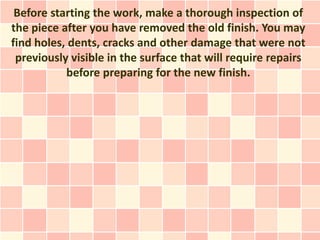
How To Prepare For A New Finish
- 1. Before starting the work, make a thorough inspection of the piece after you have removed the old finish. You may find holes, dents, cracks and other damage that were not previously visible in the surface that will require repairs before preparing for the new finish.
- 2. Some of the procedures for preparing the surface are seldom used, but are included to give you full knowledge of them. They are bleaching, scraping, sanding, staining, and filling.The choice of those to be used for a single job are determined by the type and condition of the wood, after the old finish has been removed. Some are necessary according to conditions and some are a matter of choice.
- 3. BLEACHING
- 4. Bleaching is used today mostly to remove undesirable stains. After the old finish has been removed, any darkened or discolored spots that remain can be lightened or entirely removed by the proper use of bleach. When working with pine or maple, it is best to remove discoloration and freshen up the surface.
- 6. There are four common bleaches used by home handymen to lighten wood or remove undesirable stains. They are: PREPARED BLEACH, The simplest method of getting a good bleach is to buy a prepared bleach, which usually comes in the form of two solutions that may be applied successively or mixed together, according to directions on the label.These bleaches are sold in some paint stores or through mail order outlets. HOUSEHOLD PRODUCTS, Sometimes a laundry bleach in which sodium hypo-chlorite is the bleaching agent is effective for such woods as walnut, maple, and gum. Household ammonia is a good bleaching for all but dark woods,however,it is best for spot work only. OXALIC ACID, This bleach works only when a mild bleach is needed. It can be used successfully for such open-grained woods as oak, chestnut, and
- 8. This two-solution bleach must be intermixed or applied in successive steps. All contain strong chemicals so it's important that you wear rubber gloves to protect your hands. An apron or old clothing should also be worn since these bleaches will attack most fabrics and follow the label directions carefully. These are best for overall work. They are difficult to control when spot bleaching. The bleach can be applied with a brush or sponge and should be allowed to dry on the surface until the desired effect is reached. The instructions will tell you whether neutralization or rinsing is required. After bleaching and rinsing is completed, the piece should be allowed to stand until completely dry. Then sand lightly with a very fine sandpaper to remove raised grain. Be careful not to sand more deeply than the bleach has penetrated.
- 10. Most household products are better for spot work. This is how to use laundry bleach and ammonia as bleaching agents. First,apply the product full strength over the spot or surface of the wood. Next, wash the product off with clear water after it has been on the surface about 15 minutes. Check to see if the desired color has been attained. If not, repeat the treatment. When the right color has been achieved, rinse the entire surface with water. Let the furniture stand to dry for at least 48 hours.
- 12. Oxalic acid can be purchased at a drugstore or in some paint stores. It comes in powder or crystal form. Start by dissolving 1 ounce of powder or 2 ounces of crystals in a pint of very hot water. Using a large brush, apply the solution hot to the entire surface from which the finish has been removed. Let the solution remain for 10 to 20 minutes and then wipe it off with a damp cloth. Repeat if necessary to reach the color you are after. When the proper result is reached, wash off with 1 part ammonia in 10 parts of water. This will neutralize the bleach and stop it's further action.Then wash with clear water and let it dry for at least 24 hours.
- 14. The smoothing of a wood surface is done with sandpaper by first working with relatively coarse papers, followed by those of finer grit. Steel wool is often used for final smoothing.
- 16. The sanding of a wood surface is the least difficult of all the procedures, yet it is one of the most important parts of refinishing and must always be done thoroughly and with great care. When sanding, remember these three rules. First always sand with the grain of the wood--never across the grain.Second, use straight strokes with an even pressure, avoiding a twisting or circular motion, and last, use a paper of as coarse a grit as the wood will stand without scratching, then finer ones until the surface is as smooth as the wood will become. After sanding with the finest grit paper, use a steel wool pad for the final smoothing. After using the steel wool, all dust must be removed by wiping with a tack rag. This is a cloth that is treated to attract and hold dust. It is usually available at pant dealers that handle wood finishes.